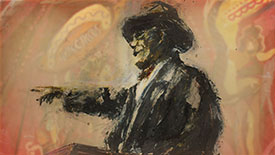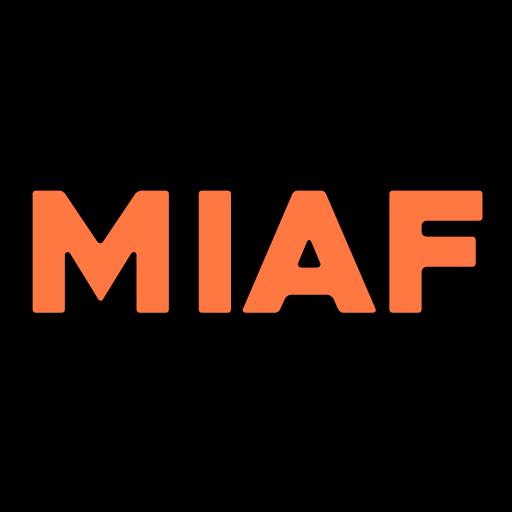
It takes time to think. Reflection tends to work best at a slower tempo. Joining dots for oneself can be a longer process than being catapulted along the shortest path from A to B. ‘Long Shorts’ is the programme that allows these types of films to stand on their merits.
Previous introductions to this programme have talked about the need to ensure we have a programming structure that does not set up an unholy trade-off in which one great 20-minute film is ditched for no other reason than to allow a clutch of shorter films to play. ‘Long Shorts’ certainly helps curb that impulse. But it also carves out a space in which these often intensely thoughtful films can find a more natural resting place as they journey through our festival.

Theodore Ushev’s latest film The Physics Of Sorrow is a fine example of all this and more. Ushev seldom does things by halves. Made at the National Film Board of Canada in Montreal, it is none-the-less based on a unique novel of the same name by Bulgarian writer Georgi Gospodinov. Released to international acclaim in 2012, it was translated into more than a dozen languages and made Gospodinov an international name in literary circles.
This is not the first time Ushev has translated Gospodinov’s work from page to screen. LIAF regulars (and anybody with even a passing passion for auteur animation) will recall Ushev’s 2016 film Blind Vaysha which was based on a Gospodinov short story. It went on to receive a nomination for an Academy Award, although it missed out to Pixar’s Piper.
To animate The Physics Of Sorrow, Ushev had to more or less (re)invent the technique known as Encaustic Painting. Although thousands of years old, it has never been used to make an animated film. It involves melting down beeswax, mixing it with colour pigments and then applying it in much the same way one applies paint. It is a technique with an extraordinary history, having been used by the early Egyptians to paint portraits of the deceased onto their internment capsules when they died. When archaeologists began discovering these treasures in the early 1900’s they were stunned at how well preserved the artworks were. In applying this beeswax ‘paint’ to paper Ushev creates paintings rich in texture imbued with a kind of restrained vibrancy that gives him the ability to depict the exact sense of movement he wanted his film to subtly radiate.
It turns out that it is a highly manipulable technique. Once painted, the wax mixture dries very quickly. But it is easy to warm up again (Ushev uses a common, garden-variety hairdryer) and this process allows for multiple chances to change and craft the picture. Additionally, when it has dried, it is also possible to carve the wax which provides abundant opportunities for creating the unusual shading and undulating finesse that is such a captivating feature of The Physics Of Sorrow.
“It is a very physical technique because it demands a lot of physical effort,” Ushev says. “And you have to be very fast because the liquid hot wax dries very fast.”
Fast is what Ushev does. It’s his party trick. He is renowned for the pace he can animate at when he gets on a roll. At nearly 30 minutes The Physics Of Sorrow required thousands of these encaustic paintings to be completed. At his peak, Ushev was turning out up to 50 a day. There are few animators capable of matching this.

Regina Pessoa’s new film Uncle Thomas: Accounting For The Days is just ravishingly, handsomely, beautiful. One of the judges at a festival in Taiwan earlier this year was asked to write the paragraph outlining why it was being awarded a Special Commendation. He penned:
“This film is a wonderful mix of classic styling perfectly blended with the superb personal art that is so recognisable as Pessoa’s. It is a film with a simple, yet authentic emotional centre and is a fine example of how, so often, the best art comes from the simplest and most individual of motivations.”
Could not have said it better myself.
Pessoa’s Uncle Thomas would never lead armies, conquer mountains or defeat tyranny, but his little eccentricities would be the first pulses of light that would begin to define the path that would lead her to a career in animation. Beyond the inspiration to begin drawing, the film’s greatest charm is really an unspoken, undefined sense that somehow it was her Uncle Thomas that opened the way for her to think like an artist.

The messages and inspirations bound up within Lia Bertels’ Dear Night do not reveal themselves as readily. That is by design. Bertels, a graduate of Belgium’s La Cambre animation school, thinks of herself as a writer as much as an animator. Her passion is to “represent the invisible in each one of us, the hidden gesture that betrays us all in our fairest character, leaving behind a profound humanism.”
Viewed through this prism, the introspectively complex little collection of animal characters that populate Dear Night are avatars for a range of the often unvoiced emotional enigmas that sometimes threaten to puncture our facades.

A similar thing is happening in Daughter, the film Daria Kashcheeva made at the FAMU animation school in Prague. Rather than dialogue, Kashcheeva relies on the directly expressive capacity of her characters eyes to build the emotional landscape her two protagonists populate.
By hand drawing every eye movement directly on to the face of her puppets, she confers a conduit of simmering personal sovereignty and almost immeasurable vulnerability in equal measure. This extraordinarily deceptive property is what gives Daughter its remarkable potency. Different people will take away different lessons from it but nobody will wonder what it is the film is trying to explore.
The programme closes with a roaring, visually saturated shout-out to the early Eastern European rave scene in all its gory glory. Acid Rain by Polish animator Tomek Popakul is about as different as it is possible to be from his previous films, including the acclaimed Ziegenort (2013), which was a quieter, more inward looking surrealist black and white film. Acid Rain, on the other hand is a veritable drenching of noise, colour and often confronting sensations.
In an interview with ‘It’s Nice That’, Popakul aptly describes the psychedelic infused colour palette he employed as “a mix of Eastern European landscape-melancholy plus the UV and new age colours of early raves from the ‘90s and maybe more contemporary Goa trance parties too,” ……if that gives you an idea.
What Popakul was chasing was a visceral sense of the chaotic and conflicting energies unleashed on and by a social group of young people experiencing a culture and a panorama of freedom they had long been denied.
“I didn’t want to pay a naïve tribute to the period. I wanted to show the dark side, too. I was intrigued by the contradictions: the feelings of family-like community and alienation in the crowd, the attempts to build a modern hippie utopia, drug-related problems and crime. I wanted to make a spiritual movie with both light and darkness. You can choose your path, but you will pay the price”
This is captured brilliantly in the prolonged dance scene upon which much of the film turns. Visually it is a stunning, powerfully rendered set piece that brings together the dangerously electric energy of the era and unleashes the emotionally distorted nature of many of its participants. Popakul spent a sizeable chunk of the film’s €50,000 budget on hiring a fully kitted out motion-capture studio and a team of professional dancers to create this part of the film. It was money well spent, and in the end, much quicker (and probably cheaper) than the more laborious methods he had been employing, to limited effect.
“It’s OK to be lost and it’s important that you are constantly searching.”
Popakul muses. True enough, but it can take time to find that spot and making that kind of time is exactly what Long Shorts was built for.
International Competition Programme 8: Long Shorts screens at Barbican 3rd Dec 20:45 book tickets
Malcolm Turner
















